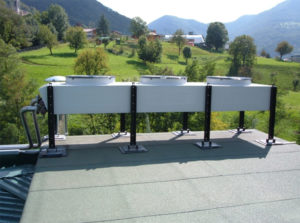

There are several ways for the automation of a free cooling system, that allow even sophisticated regulation levels of temperature control and fans’ powering using inverters. For the part aimed to the temperature regulation, it is possible to choose between two options, a basic and an advanced one.
The simple installation of a double sensor regulator allows to check the temperature gap between the ambient air and the fluid to be cooled: in case the ambient air is cooler than the fluid, the device pilots a three way switching valve that provides the continuous functioning of the free cooling circuit, whereas when the air temperature increases, the system bypass the fluid directly to the chiller.
In case of more sophisticated and articulated needs, it is possible to implement a PLC, which is nowadays an affordable option even for contained dimension plants. A basic PLC is able to manage basic in and out signals, thanks to a simple dedicated software, achieving a sophisticated and customized management and, most of all, simplified of the cooling system operations.
The control of the fan section drives in a free cooler can be managed using smart regulation solutions that optimize the efficiency of the system, maximizing the cooperation in series between the free cooler and the chiller. These are management systems based on a PLC that minimize the power consumption, also offering the possibility to implement adiabatic boosting systems in order to increase the overall dissipation efficiency of the machinery. They also employ electronically commutated EC motors managed by EC controllers, allowing a highly precise speed regulation. The EC motors are indeed managed by EC controllers that regulate the operating speed of the fan groups based on the real production needs of served utilities, ensuring very high energy efficiency without any electromagnetic interference. This fact can be very relevant on plants working throughout the whole year, such as biogas cogeneration plants, returning in a shorter time the investment costs of an EC fan, and also engendering a significant benefit due to the fact that it is possible to sell the saved KWs to the managing authority.
Another element making EC motors and drives worth it is the noise aspect: free coolers have indeed in common with chillers and evaporative towers the fan section, and therefore the related noise generated. In order to integrate free cooler in residential contexts, the selection of quite and low noise fan solutions thus becomes mandatory, joined with EC motors that, in addition to the energy savings explained above, provide a significant noise reduction.
